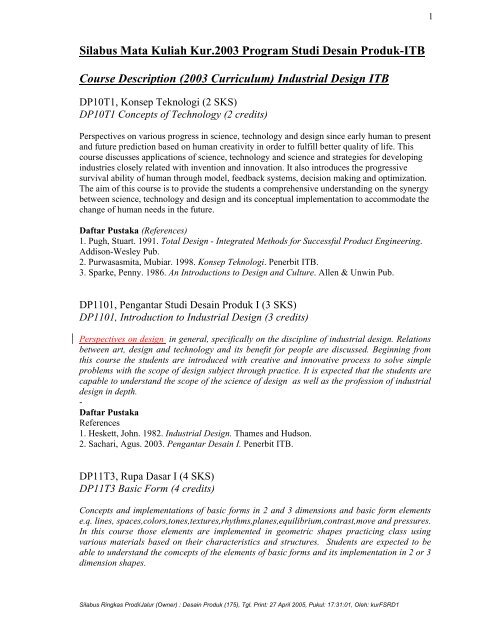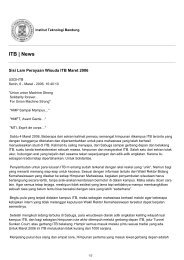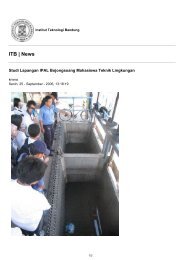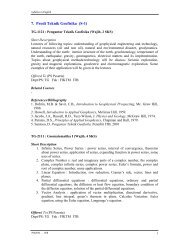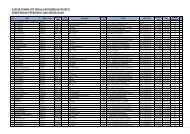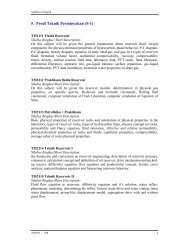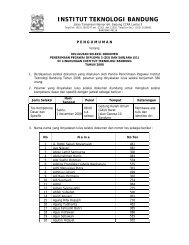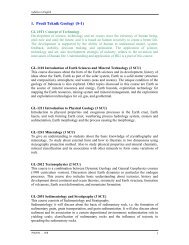Silabus Mata Kuliah Kur.2003 Program Studi Desain Produk-ITB ...
Silabus Mata Kuliah Kur.2003 Program Studi Desain Produk-ITB ...
Silabus Mata Kuliah Kur.2003 Program Studi Desain Produk-ITB ...
Create successful ePaper yourself
Turn your PDF publications into a flip-book with our unique Google optimized e-Paper software.
1<br />
<strong>Silabus</strong> <strong>Mata</strong> <strong>Kuliah</strong> <strong>Kur.2003</strong> <strong>Program</strong> <strong>Studi</strong> <strong>Desain</strong> <strong>Produk</strong>-<strong>ITB</strong><br />
Course Description (2003 Curriculum) Industrial Design <strong>ITB</strong><br />
DP10T1, Konsep Teknologi (2 SKS)<br />
DP10T1 Concepts of Technology (2 credits)<br />
Perspectives on various progress in science, technology and design since early human to present<br />
and future prediction based on human creativity in order to fulfill better quality of life. This<br />
course discusses applications of science, technology and science and strategies for developing<br />
industries closely related with invention and innovation. It also introduces the progressive<br />
survival ability of human through model, feedback systems, decision making and optimization.<br />
The aim of this course is to provide the students a comprehensive understanding on the synergy<br />
between science, technology and design and its conceptual implementation to accommodate the<br />
change of human needs in the future.<br />
Daftar Pustaka (References)<br />
1. Pugh, Stuart. 1991. Total Design - Integrated Methods for Successful Product Engineering.<br />
Addison-Wesley Pub.<br />
2. Purwasasmita, Mubiar. 1998. Konsep Teknologi. Penerbit <strong>ITB</strong>.<br />
3. Sparke, Penny. 1986. An Introductions to Design and Culture. Allen & Unwin Pub.<br />
DP1101, Pengantar <strong>Studi</strong> <strong>Desain</strong> <strong>Produk</strong> I (3 SKS)<br />
DP1101, Introduction to Industrial Design (3 credits)<br />
Perspectives on design in general, specifically on the discipline of industrial design. Relations<br />
between art, design and technology and its benefit for people are discussed. Beginning from<br />
this course the students are introduced with creative and innovative process to solve simple<br />
problems with the scope of design subject through practice. It is expected that the students are<br />
capable to understand the scope of the science of design as well as the profession of industrial<br />
design in depth.<br />
-<br />
Daftar Pustaka<br />
References<br />
1. Heskett, John. 1982. Industrial Design. Thames and Hudson.<br />
2. Sachari, Agus. 2003. Pengantar <strong>Desain</strong> I. Penerbit <strong>ITB</strong>.<br />
DP11T3, Rupa Dasar I (4 SKS)<br />
DP11T3 Basic Form (4 credits)<br />
Concepts and implementations of basic forms in 2 and 3 dimensions and basic form elements<br />
e.q. lines, spaces,colors,tones,textures,rhythms,planes,equilibrium,contrast,move and pressures.<br />
In this course those elements are implemented in geometric shapes practicing class using<br />
various materials based on their characteristics and structures. Students are expected to be<br />
able to understand the comcepts of the elements of basic forms and its implementation in 2 or 3<br />
dimension shapes.<br />
<strong>Silabus</strong> Ringkas Prodi/Jalur (Owner) : <strong>Desain</strong> <strong>Produk</strong> (175), Tgl. Print: 27 April 2005, Pukul: 17:31:01, Oleh: kurFSRD1
2<br />
Daftar Pustaka<br />
References:<br />
1. Arnkil, Harald. 1995. Aspect of Colour. The University of Art and Design-Helsinki<br />
2. Nunn, Bob and Chris Locke. 1984. Art Related Topics. Related <strong>Studi</strong>es for Art and Design<br />
Students. Longman.<br />
3. Wong, Wucius & Adjat Sakri. 1987. Beberapa Azas Merancang Nirmana Trimatra. Penerbit<br />
<strong>ITB</strong>.<br />
4. Wong, Wucius & Adjat Sakri. 1968. Beberapa Azas Merancang Nirmana Dwimatra.<br />
Penerbit <strong>ITB</strong>.<br />
DP1202, Pengantar <strong>Studi</strong> <strong>Desain</strong> <strong>Produk</strong> II (3 SKS)<br />
DP1202 Introduction to Industrial Design II (3 credits)<br />
Perspectives on design and its relation with national development. Figures of national as well<br />
international design are presented, progress of industrial design and its prospect in the future<br />
and startegies of design of industrial countries and their developed products. In this course<br />
students are given with opportunity to develop their critical thinking capabilities to solve design<br />
problems through creative and innovative approaches. Also from this course students are<br />
expected to be able to envision the conncetion between industrial design discipline with<br />
national long term development program and its progress worldwide.<br />
Daftar Pustaka<br />
1. Mayall, John. 1986. Design Principles. Thames and Hudson.<br />
2. Sachari, Agus. 2003. Pengantar <strong>Desain</strong> II. Penerbit <strong>ITB</strong>.<br />
DP12T4, Rupa Dasar II (4 SKS)<br />
DPT12T4 Basic Form II<br />
Extension on the concepts and applications of 2 and 3 dimensional basic design. Depth<br />
observation and practice on various aspects of basic form and experiments with various<br />
methods to exercise the sensitivity to surface characteristics, color & tone and the artistic<br />
effects of etches, strokes, rip-off and folding. Observation over 3-D basic design is emphasized<br />
to develop sensitivity over spaces, shapes, surface properties and logical thinking ability in<br />
constructing compositions, either in geometrical or organic objects. The students are expected<br />
to be able to develop sensitivity upon differences of each element of form in geometrical and<br />
organic objects and its application in 2 and 3 dimensional shapes.<br />
Daftar Pustaka<br />
1. Arnkil, Harald. 1995. Aspect of Colour. The University of Art and Design-Helsinki<br />
2. Nunn, Bob & Chris Locke. 1984. Art Related Topics. Related <strong>Studi</strong>es for Art and Design<br />
Students. Longman.<br />
3. Wong, Wucius & Adjat Sakri. 1987. Beberapa Azas Merancang Nirmana Trimatra. Penerbit<br />
<strong>ITB</strong>.<br />
4. Wong, Wucius & Adjat Sakri. 1968. Beberapa Azas Merancang Nirmana Dwimatra.<br />
Penerbit <strong>ITB</strong>.<br />
<strong>Silabus</strong> Ringkas Prodi/Jalur (Owner) : <strong>Desain</strong> <strong>Produk</strong> (175), Tgl. Print: 27 April 2005, Pukul: 17:31:01, Oleh: kurFSRD1
3<br />
DP2051, <strong>Desain</strong> <strong>Produk</strong> I (6 SKS)<br />
DP2051, Industrial Design I (6 credits)<br />
Industrial product design, with emphasis on the shape experimentation aspect and exploration<br />
over the esthetics of visual language: semantics, semiotics, expression, symbolic and<br />
physiogonomy. Objects of interest including handle, handheld products, seating facilities, or<br />
other similar products. Goal of this course is the students become capable of designing a<br />
product with emphasis on the form and esthetics of form language which must be implemented<br />
through various experiments and explorations<br />
Daftar Pustaka<br />
1. Lawson, Bryan. 1990. How Designers Think. Butterworth Architecture.<br />
2. Roukes, Nicholas. 1988. Design Synectics, Stimulating Creativity in Design. Davis Pub.<br />
3. Vihma, Susan (ed.).1990. Semantic Vision in Design. UIAH-Helsinki.<br />
4. Wallschlaeger, Charles. 1992. Basic Visual Concepts and Principles. Brown Pub.<br />
DP2052, <strong>Desain</strong> <strong>Produk</strong> II (6 SKS)<br />
DP2052, Industrial Design II (6 credits)<br />
Industrial product design, with emphasis on the engineering creativity and scientific principles<br />
to yield a unique and new functionality. Extension of course scope including innovation,<br />
modification, inspiration, improvement on single or several creative products such as toys,<br />
household appliances, educational daily tools or other similar products.<br />
The course is aimed to enable the students to design a product based on application of scientific<br />
of engineering principles in creative way.<br />
Daftar Pustaka<br />
1. Greenwood, Douglas. 1986. Product Engineering Design Manual. Mc Graw Hill.<br />
2. Pahl & Beitz. 1984. Engineering Design. The Design Council.<br />
3. Pugh, Stuart. 1991. Total Design - Integrated Methods for Successful Product Engineering.<br />
Addison-Wesley Pub. Ltd.<br />
4. Tahkokallio, Paivi (ed.). 1995. Design-Pleasure or Responsibility ?. The University of Art<br />
and Design-Helsinki.<br />
DP2164, Semantika <strong>Produk</strong> I (2 SKS)<br />
DP2164, Product Semantics I (2 credits)<br />
Perspectives and understanding on various aspects pertinent to the semantic theory of visual<br />
language, including image, semiotics, meaning, symbolic elements, ideology and metaphors.<br />
Also discussed in this course the applications of the theories in product design process and their<br />
related cultural phenomena. It is expected at the end of course the student obtains a<br />
comprehensive understanding on fundamental theories on the semantics of visual language and<br />
how to apply it to a product design.<br />
<strong>Silabus</strong> Ringkas Prodi/Jalur (Owner) : <strong>Desain</strong> <strong>Produk</strong> (175), Tgl. Print: 27 April 2005, Pukul: 17:31:01, Oleh: kurFSRD1
4<br />
Daftar Pustaka<br />
1. Vakeppa. 1990. Product Semantics. UIAH-Helsinki.<br />
2. Vihma, Susan (ed). 1995. Product as Representation. UIAH-Helsinki.<br />
3. Wallsschlaeger, Charles. 1992. Basic Visual Concept and Principles. Brown Pub.<br />
DP2183, Gambar Teknik (2 SKS)<br />
DP2183, Technical Drawing (2 credits)<br />
Introduction and basics of technical drawing, including concept of various projection methods,<br />
instrument and tools for drawing, standards on papers and working plan. The course also<br />
introduces drawings based on standards established by ISO and mastering the skills to realize<br />
design idea into standardized drawings. The aim of this course is to give understanding to the<br />
students on the principles of technical drawing and mastery of technical drawing process based<br />
on the established standards.<br />
Daftar Pustaka<br />
1. Gieseche, Prederick E., dkk. 2000. Gambar Teknik. Jilid I dan II. Penerbit Erlangga.<br />
2. Goetsch, David L & John A. Nelson. 1986. Technical Drawing and Design. Delmar Pub.<br />
3. Sato, G. Takeshi. 1994. Menggambar Mesin Menurut standar ISO. Pradnya Paramita.<br />
DP2186, Teknik Presentasi I (2 SKS)<br />
DP2186, Presentation Technique (2 credits)<br />
Introduction and concepts on fundamental of drawing techniques required for presentation. The<br />
course introduces various media (soft pastel, air brush, marker, color pencils, poster paint,<br />
etc). Also introduced in this course the verbal and descriptive presentation techniques to<br />
prepare proposal and design portofolio. The goal of this course is to enable the students to<br />
perform presentation and prepare the supporting items including written and pictorial<br />
description.<br />
Daftar Pustaka<br />
1. Arnkil, Harald (ed.). 1995. Aspect of Colour. The University of Art and Design-Helsinki.<br />
2. Gill, Robert W. 1991. Basic Rendering. Thames and Hudson.<br />
3. Vickers, Graham. 1994. Style in Product Design. Design Council.<br />
DP2182, Bahan dan Proses <strong>Produk</strong>si (2 SKS)<br />
DP2182, Material and Production Process (2 credits)<br />
Perspectives and introduction to various materials, either natural or synthetic and composite<br />
commonly used for product manufacturing. Also introduced in this course application of<br />
materials for a product based on their physical and chemical properties. Process of forming<br />
and shaping the material by cutting, abrating, fondry, stamping, coating, etc are also given. At<br />
the end of this course students are expected to be able to understand the physical and chemcal<br />
properties of a material and the related processing and forming stage as the consideration<br />
when they are about to apply them in a product design<br />
<strong>Silabus</strong> Ringkas Prodi/Jalur (Owner) : <strong>Desain</strong> <strong>Produk</strong> (175), Tgl. Print: 27 April 2005, Pukul: 17:31:01, Oleh: kurFSRD1
5<br />
Daftar Pustaka<br />
1. Cornish, E.H. 1987. Materials and the Designer. Cambridge University Press.<br />
2. De Gramo. 1980. Material and Process in Manufacturing. Collier Mc Milan.<br />
3. Vlack. 1986. Ilmu Teknologi Bahan. Penerbit Erlangga.<br />
DP2265, Semantika <strong>Produk</strong> II (2 SKS)<br />
DP2265, Product Semantics II (2 credits)<br />
Further exploration of perspectives and understanding on various aspects pertinent to the<br />
semantic theory of form language as continuation of theories discussed in Product Semantics I<br />
with additional material on symbolic elements, communication, grouping and their application.<br />
Also discussed in this course how to implement those theories in product design process as<br />
well as the related cultural phenomena. By the end of this course students are expected to be<br />
capable of implementing semantic theories of form language and performing experiments of<br />
design through creative application of the discussed theories<br />
Daftar Pustaka<br />
1. Vakeppa. 1990. Product Semantics. UIAH-Helsinki.<br />
2. Vihma, Susan (ed.). 1995. Product as Representation. UIAH-Helsinki.<br />
3. Vihma, Susan (ed.).1990. Semantic Vision in Design. UIAH-Helsinki.<br />
4. Wallsschlaeger, Charles. 1992. Basic Visual Concept and Principles. Brown Pub.<br />
DP2281, Prinsip Rekayasa (2 SKS)<br />
DP2281, Basic Engineering in Design (2 credits)<br />
Perspectives and concepts of principles in engineering, including structure and construction,<br />
mechanical equipments, aerodynamics of vehicle, hydrodynamics of ships, electronic circuits<br />
and their principles of operation, working principles of mechatronics equipments, automation,<br />
basic principles of optics, instrumentation, network system, principles of artificial brain ,<br />
introduction to control, etc. Also discussed several cases of innovative products which<br />
implementing engineering principles both experimentally or its their application concepts. The<br />
students are expected by the end of this course to be capable of understanding various<br />
principles in engineering and implementing them in a product design stage.<br />
Daftar Pustaka<br />
1. Cornish, E.H. 1987. Materials and the Designer. Cambridge University Press.<br />
2. Flurscheim, Charles H. (ed.). 1983. Industrial Design in Engineering, A Marriage of<br />
Technique. The Design Council.<br />
3. Greenwood, Douglas. Mechanical Detail for Product Design. Mc Graw-Hill.<br />
<strong>Silabus</strong> Ringkas Prodi/Jalur (Owner) : <strong>Desain</strong> <strong>Produk</strong> (175), Tgl. Print: 27 April 2005, Pukul: 17:31:01, Oleh: kurFSRD1
6<br />
DP2284, Pemodelan Digital I (3 SKS)<br />
DP2284, Digital Modelling I (3 credits)<br />
Practical session of introduction and the mastery on fundamental of computer softwares for<br />
modeling and simulation applications, including principles of CAD softwares such as<br />
AutoCAD, 3D <strong>Studi</strong>o, 3D Max, Alias, Pro-Eng, etc. In parallel with theories the students also<br />
exercise the basics of drawing and its special effects as well as the principles of rapid<br />
prototyping. At the end of the course students should be able to master the basic applications of<br />
softwares for digitally producing model and simple simulation of a product<br />
Daftar Pustaka<br />
1. Negroponte, Nicholas. 1998. Being Digital., Penerbit Mizan.<br />
2. Pipes, Alan. 1990. Drawing for 3 Dimensional Design : Concepts-Illustration-Presentation.<br />
John Calman and King.<br />
3. Sriwarno, Andar Bagus, dkk.1999. Pengantar <strong>Studi</strong> Pemodelan Digital. Penerbit <strong>ITB</strong>.<br />
DP2287, Teknik Presentasi II (3 SKS)<br />
DP2287, Presentation Techniques II (3 credits)<br />
Introduction and exploration on fundamentals of model making for presentation purpose.<br />
Exploration over various materials for constructing models (clay model, plastik maket, rigid<br />
foam, dsb), forming & making the models as well several pertinent finishing techniques and<br />
scaling the model required for the presentation. It is expected at the end of the course the<br />
students have the ability to make reprsentative model of a product to support effective<br />
presentation needs.<br />
Daftar Pustaka<br />
1. Powell, Dick. 1995. Presentation Technique. Orbis.<br />
2. Vickers, Graham. 1994. Style in Product Design. Design Council.<br />
DP2288, Praktik Bengkel Kerja (4 SKS)<br />
DP2288, Workshop Practice (4 credits)<br />
Practical session in a workshop to create a product made from solid wood material based on<br />
technical drawing previously prepared. Also introduced in this course various types of manual<br />
or semi-mechanical machines and tools, characteristics of material, types of joins and<br />
constructions, and finishing techniques. After completing this course the students are expected<br />
to be able to operate various manual or semi-machinal to create various components connected<br />
with certain types of joint systems to be assembled later as a product.<br />
Daftar Pustaka<br />
1. Hall, Mike. 1988. Design and Plastics. Hodder and Stoughton.<br />
2. Love, George. 1996. Teori dan Praktek Kerja Logam. Penerbit Erlangga.<br />
3. Sriwarno, Andar Bagus. 1999. Suplemen <strong>Kuliah</strong> Workshop Kayu dan Metal. Penerbit <strong>ITB</strong>.<br />
<strong>Silabus</strong> Ringkas Prodi/Jalur (Owner) : <strong>Desain</strong> <strong>Produk</strong> (175), Tgl. Print: 27 April 2005, Pukul: 17:31:01, Oleh: kurFSRD1
7<br />
DP3053, <strong>Desain</strong> <strong>Produk</strong> III (6 SKS)<br />
DP3053, Industrial Design III (6 credits)<br />
Industrial product design based on innovation aspects of industrial manufacturing and the<br />
related marketing issues: industrial capacities and capabilities associated with characteristics,<br />
segmentation, trend and marketing strategic of the products as well as their global issues.<br />
Design observation will be carried out in the environment of pertinent industry and its various<br />
market survey. The object of design may vary but should be within the scope of industrial<br />
design. At the end of the course the students are expected to be able to design a creative and<br />
innovative product based on the characteristics of the industry where the case study takes place<br />
along with the related target market.<br />
Daftar Pustaka<br />
1. Bruce, Margaret. 1995. Product Development. John Wiley & Sons.<br />
2. Hollins, Bill. 1990. Succesfull Product Design. Butterworths & Co.<br />
3. Kotler, Philips. 1996. Manajemen Pemasaran, Jilid I dan II. Penerbit Erlangga<br />
DP3054, <strong>Desain</strong> <strong>Produk</strong> IV (6 SKS)<br />
DP3054, Industrial Design IV (6 credits)<br />
Industrial product design based on social aspects within the following scope: the use of<br />
alternative technology, poverty elimination, job opening, adding product values, informal sector<br />
empowerment, participatory design, design for the underdeveloped societies, gender issues,<br />
environmental issues, local culture initiatives and problems in developed countries. At the end<br />
of the course it is expected that the students develop ability to design an innovative and creative<br />
product based on the social and cultural approaches and the related issues comprehensively.<br />
Daftar Pustaka<br />
1. Kartasasmita, Ginanjar. 1996. Pembangunan Untuk Rakyat. CIDES.<br />
2. Papanek, Victor. 1995. The Green Imperative. Thames and Hudson.<br />
3. Sachari, Agus. 2003. <strong>Desain</strong> dan Permasalahan Pembangunan. Penerbit <strong>ITB</strong>.<br />
DP3163, Metode <strong>Desain</strong> <strong>Produk</strong> (2 SKS)<br />
DP3163, Industrial Design Method (2 SKS)<br />
Introduction and concepts of various theoretical backgrounds and understanding of design and<br />
the procedures to solve design problem methodologically. The course is aimed to construct a<br />
systematic yet creative structure of thinking by exposing illustrations on general design process.<br />
The goal of this course is to enable the student to apply various alternatives of design process<br />
systematically and creatively in order to particularly solve or offer solution of industrial design<br />
problems.<br />
<strong>Silabus</strong> Ringkas Prodi/Jalur (Owner) : <strong>Desain</strong> <strong>Produk</strong> (175), Tgl. Print: 27 April 2005, Pukul: 17:31:01, Oleh: kurFSRD1
8<br />
Daftar Pustaka<br />
1. Lawson, Bryan. 1990. How Designers Think. Butterworth Architecture.<br />
2. Pugh, Stuart. 1991. Total Design - Integrated Methods for Successful Product Engineering.<br />
Addison-Wesley Pub.<br />
3. Roozenburg, N.F.M. & J. Eekels. 1995. Product Design: Fundamentals and Methods. John<br />
Wiley & Sons.<br />
DP3171, Ergonomi <strong>Desain</strong> I (2 SKS)<br />
DP3171, Ergonomics Design I (2 credits)<br />
Introduction and concept of the science, research and standardization of ergonomy in relation<br />
with design problems in Inodonesia. Understanding on the application of anthropometric<br />
standards (human body measurements, reference percentile, eye reference point, seat reference<br />
point, finger reference point, reach, position,etc) ergonomic consideration on design process<br />
(safety factor, safety,comfort, health,communication,operability, work oprimization,etc). Also<br />
introduced in this course several ergonomy test methods applied to various product cases,<br />
working surface and working space. It is expected from this course that the students have<br />
understanding on various ergonomic realibilities and capable to apply them on a product<br />
design process.<br />
Daftar Pustaka<br />
1. Pasaribu, Martinus Y. 1997. Pengantar Ergonomi, Jilid I dan II. Penerbit <strong>ITB</strong>.<br />
2. Sanders, Mark & Ernest Mc Cormick. 1993. Human Factors in Engineering And Design. Mc<br />
Graw Hill.<br />
3. Woodson, Wesley E. 1993. Human Factor Design Handbook. Mc Graw Hill.<br />
DP3173, Manajemen Pemasaran <strong>Produk</strong> (2 SKS)<br />
DP3173, Marketing Management (2 credits)<br />
Daftar Pustaka<br />
1. Engel, James F. 1993. Consumer Behavior. The Dryden Press.<br />
2. Kotler, Philips. 1996. Manajemen Pemasaran, jilid I dan II. Penerbit Erlangga.<br />
3. Ramli, Rizal, dkk. 1997. Liberalisasi Ekonomi dan Politik Indonesia. PPM FE-UI.<br />
DP31HC, Sejarah <strong>Desain</strong> I (2 SKS)<br />
DP31HC, Design History I (2 credits)<br />
Perspectives on the progress of modern design in Indonesia from socio-historical point of view<br />
since the 19th and 20th centuries, both on product culture and artefacts. Exposition incluing<br />
various phenomena on the growth consumer society and progressive life style particularly in the<br />
colonial era, the establishment of “Ethics Politics”, the independence era (1945), synergic<br />
between the modernization program and modernism, the fall of “Orde Lama” (1965) and “Orde<br />
Baru” (1998), crisis in Indonesia in the end of 20th century and the western strategy of culture<br />
for developing countries with its infiltration. It is expected that at the end of the course the<br />
students are capable of understanding various backgrounds on socio-historic design progress in<br />
Indonesia in the past as the basis to ancipate the future progress.<br />
<strong>Silabus</strong> Ringkas Prodi/Jalur (Owner) : <strong>Desain</strong> <strong>Produk</strong> (175), Tgl. Print: 27 April 2005, Pukul: 17:31:01, Oleh: kurFSRD1
9<br />
Daftar Pustaka<br />
1. Sachari, Agus & Yanyan Sunarya. 2002. Sejarah dan Perkembangan <strong>Desain</strong> Indonesia.<br />
Penerbit <strong>ITB</strong>.<br />
2. Siahaan, Bisuk. 1996. Industrialisasi di Indonesia. Pustaka Data.<br />
DP3272, Ergonomi <strong>Desain</strong> II (2 SKS)<br />
DP3272, Ergonomics Design II (2 credits)<br />
Introduction and concepts of the theories and discussions on ergonomic cognitive, humancentered<br />
design, dan ergonomic total quality in particular for several industrial cases of both<br />
complex systems (cockpit design, vehicle design, emergency equipments,etc) and simple<br />
products (household appliances). This course also analyzes problems related to human errors<br />
in using the products, the impacts and various solution approaches. It is expected that the<br />
students by the end of this course will be able to perform analytical exploration over ergonomy<br />
aspects and apply it to a product design.<br />
Daftar Pustaka<br />
1. Pasaribu, Martinus Y. 1997. Pengantar Ergonomi, jilid I dan II. PSDP-<strong>ITB</strong>.<br />
2. Sanders, Mark & Ernest Mc Cormick. 1993. Human Factors in Engineering And Design. Mc<br />
Graw Hill.<br />
3. Wilson, John (ed). 1990. Evaluation of Human Work. Taylor & Francis Inc.<br />
4. Woodson, Wesley E. 1993. Human Factors Design Handbooks. Mc Graw Hill.<br />
DP3274, Manajemen <strong>Desain</strong> (2 SKS)<br />
DP3274, Design Management(2 credits)<br />
Perspectives and concepts on design activities in industries with emphasis on the aspects of<br />
design organization, manipulating ideas, decision making techniques, design working<br />
procedures, design activities management, cost calculation, product competition, design<br />
strategy,etc. Also discussed in this course the international design business and their<br />
management. It is expected from this course that student will be able to understand the<br />
principles of desiogn activities and systematically and efficiently implement them in related<br />
industries.<br />
Daftar Pustaka<br />
1. Amir, Sulfikar. 2001. Pengantar Manajemen <strong>Desain</strong>. Penerbit <strong>ITB</strong>.<br />
2. Mott, Richard. 1989. Managing a Design Practice. Architecture Design and Technology<br />
Press.<br />
3. Oakley, Mark. 1990. Design Management. A Hand Book of Issue and Methods. Blackwell.<br />
DP3277, Sosiologi <strong>Desain</strong> (2 SKS)<br />
DP3277, Sociology of Design (2 credits)<br />
Perspectives and concepts on various methods in sociology and thoughts in the theory of<br />
sociology. Also given in this course on synergic relations between design and social strata,<br />
dynamics and social change, mentality, social behavior, social-politics and relation of design<br />
with the society lifestyle. It is expected from this course that the student will be able to<br />
understand social facts and reality and various demands in the society, particular those<br />
<strong>Silabus</strong> Ringkas Prodi/Jalur (Owner) : <strong>Desain</strong> <strong>Produk</strong> (175), Tgl. Print: 27 April 2005, Pukul: 17:31:01, Oleh: kurFSRD1
10<br />
selected as consideration for designing a product.<br />
Daftar Pustaka<br />
1. Sachari, Agus. 2002. Sosiologi <strong>Desain</strong>. Penerbit <strong>ITB</strong>.<br />
2. Soekanto, Soerjono. 1996. Sosiologi Suatu Pengantar. Rajawali Pers.<br />
3. Tomlinson, Alan. 1991. Consumption, Identity & Style. A Comedia Book.<br />
DP32HD, Sejarah <strong>Desain</strong> II (2 SKS)<br />
DP32HD, History of Design II (2 credits)<br />
Perspectives on the chronological progress of design especially in United States, Europe and<br />
other countries in the mid 19 th until the end of 20 th century. Also exposed the influence of the<br />
progress of technology and its socio-polical change background., modern thinking methodology<br />
and its influence in design, the emerge of Rationalism and Industrial Revolution in Europe, the<br />
birth of Art Noveau and Art Deco, the influence of Arts & Crafts movement, the emerge of<br />
modernism and the following movements up to the Post-modernsim era. It is expected from this<br />
course that the student wil be able to understand the socio-historical background of the design<br />
progress in Indonesia in the past as the basis to anticipate progress in the future.<br />
Daftar Pustaka<br />
1. Pirovano, Carlo (ed.). 1990. History of Industrial Design. Volume I, II, III. Electa.<br />
2. Sachari, Agus. 2003. Sejarah <strong>Desain</strong> Modern. Penerbit <strong>ITB</strong>.<br />
3. Sachari, Agus & Yanyan S. 1998. Modernisme. Tinjauan Historis <strong>Desain</strong> Modern. Balai<br />
Pustaka.<br />
DP4055, <strong>Desain</strong> <strong>Produk</strong> V (6 SKS)<br />
DP4055, Industrial Design V (6 credits)<br />
Industrial product design based on the innovation of technology and system and various<br />
problems in the future. The design process is conducted in collaboration with other disciplines,<br />
with the scope of implementation may include the application of advanced tecchnolofy, new<br />
innovation, foreseeing the application of future technology or product development at certain<br />
degree of complexity. It is expected that by the end of the course the students will be able to<br />
design a creative and innovative product in multidisciplinary fashion with other subject.<br />
Daftar Pustaka<br />
1. Bruce, Margareth. 1995. Product Development. John Wiley & Sons.<br />
2. Pugh, Stuart. 1995. Total Design. Integrated Methods for Successful Product Engineering.<br />
Addison-Wesley Pub.<br />
3. Sachari, Agus. 2003. <strong>Desain</strong> dan Teknologi. Penerbit <strong>ITB</strong>.<br />
<strong>Silabus</strong> Ringkas Prodi/Jalur (Owner) : <strong>Desain</strong> <strong>Produk</strong> (175), Tgl. Print: 27 April 2005, Pukul: 17:31:01, Oleh: kurFSRD1
11<br />
DP4056, Kolokium <strong>Desain</strong> <strong>Produk</strong> (3 SKS)<br />
DP4056, Colloquium of Industrial Design (3 credits)<br />
Preparatory course for Final Project of Industrial Design, administered in several meetings,<br />
seminars and presentation of the final project plan. The course scope is grouped into 4<br />
categories: (1) Investigation in design & technology- innovation of technology and its relation<br />
with the discipline of industrial design, (2)Investigation of Design and Lifestyle – varieties of<br />
the socio-cultural identities of product users, (3) Investigation of Design and Environment –<br />
spatial and system aspects in living environment and (4) Investigation of Design and Human<br />
Factor – operational aspects of a product in relation with ergonomy points of view and<br />
physical & physiological safety factor of the user. By the end of this course the students are<br />
expected to be able to systematically investigate and explain various problems in the field<br />
he/she has chosen in relation with the discipline of industrial design.<br />
Daftar Pustaka<br />
1. PSDP-<strong>ITB</strong>. 1998. Pedoman Kolokium <strong>Desain</strong> <strong>Produk</strong>. Penerbit <strong>ITB</strong><br />
2. Aneka pustaka yang relevan dengan bidang kajian dan topik Kolokium <strong>Desain</strong> <strong>Produk</strong>.<br />
DP40K0, Kerja Profesi <strong>Desain</strong> <strong>Produk</strong> (3 SKS)<br />
DP40K0, Industrial Design Professional Practice(3 credits)<br />
Professional practices which can be performed in the following: manufacturing industries,<br />
design firm, scientific or professional research & development centers/institutes/offices related<br />
to the field of industrial design, higher education institutes/universities or private or state<br />
industrial sectors both national or international. The scope of activities might include: the<br />
planning and design of product, production process, design policy or design management. It is<br />
expected by the end of this course the students will be able to widen his/her perspectives and<br />
improve the knowledge from professional point of view within the scope of the field of<br />
industrial design.<br />
Daftar Pustaka<br />
References:<br />
1. PSDP-<strong>ITB</strong>. 2000. Pedoman Kerja Profesi <strong>Desain</strong> <strong>Produk</strong>. Penerbit <strong>ITB</strong>.<br />
2. Relevent references with the activities of Industrial Design Professional Practices<br />
DP40S0, Seminar <strong>Desain</strong> <strong>Produk</strong> (3 SKS)<br />
DP40S0, Seminar of Industrial Design (3 credits)<br />
This course is administered in several meetings, seminars and presentation of the final project<br />
plan. The scope includes various social phenomena pertinent to the progress of design<br />
particularly in Indonesia. The emphasis is on the systematical and analytical exposition<br />
methods based on specific concepts. It is expected by the end of this course the students will be<br />
able to systemtically and analytically observe and report the various influencing social and<br />
cultural phenomenain Indonesia both oral and written.<br />
<strong>Silabus</strong> Ringkas Prodi/Jalur (Owner) : <strong>Desain</strong> <strong>Produk</strong> (175), Tgl. Print: 27 April 2005, Pukul: 17:31:01, Oleh: kurFSRD1
12<br />
Daftar Pustaka<br />
1. PSDP-<strong>ITB</strong>. 2003. Pedoman Seminar <strong>Desain</strong> <strong>Produk</strong>.<br />
2. Relevent references within the scope and topics in Seminar of Industrial Design.<br />
DP40Z0, Tugas Akhir/Skripsi <strong>Desain</strong> <strong>Produk</strong> (6 SKS)<br />
DP40Z0, Final Project of Industrial Design (6 credits)<br />
Industrial design product or research through comprehensive and innovative approaches based<br />
on theme, conceptual, experimental or scientific approaches. The scope is aspects on soci0-<br />
cultiral. Esthetics, ergonomy, production system, technology or the market opportunity. The<br />
output of final project and final report is a comprehensive design proposal/design portfolio<br />
and theoretical investigation of a conducted research in the form of written report presented in<br />
the final project/report defense session. It is expected that by the completion of this course the<br />
students will be able to perform various research activites and in particular to individually and<br />
professionally work in relevance with the field of discipline or profession of industrial design<br />
Daftar Pustaka<br />
1. PSDP-<strong>ITB</strong>.2003, Pedoman Tugas Akhir <strong>Desain</strong> <strong>Produk</strong>.<br />
2. Various references in relevance within the scope and topics of Final Project/Report<br />
DP4185, Pemodelan Digital II (3 SKS)<br />
DP4185, Digital Modelling II (3 credits)<br />
Practical session on the advanced application of computer software for modeling and<br />
simulation of the design output product by means of various application softwares previously<br />
introduced in Digital Modelling I. Complexity degree of the product, the output simulation and<br />
the other material comprehension distinguish this course from the previous counterpart. The<br />
scope of this course includes the rendering capability of various technical drawing, 3D<br />
presentation drawing, shadow and material type effects, the concept of virtual reality,<br />
animation, compilation of several softwares and rapid prototyping. The students are expected<br />
by the end of this course to be able to use various application software to produce model,<br />
simulation and animation of a product with the related digital systems.<br />
Daftar Pustaka<br />
1. Eppinger, Steven D. & Ulrich, Karl T. 1995. Product Design and Development. Mc Graw<br />
Hill.<br />
2. Negroponte, Nicholas. 1998. Being Digital. Penerbit Mizan.<br />
3. Pipes, Alan. 1990. Drawing for 3 Dimensional Design : Concepts-Illustration-Presentation.<br />
John Calman and King.<br />
<strong>Silabus</strong> Ringkas Prodi/Jalur (Owner) : <strong>Desain</strong> <strong>Produk</strong> (175), Tgl. Print: 27 April 2005, Pukul: 17:31:01, Oleh: kurFSRD1
13<br />
DP4275, Wirausaha <strong>Desain</strong> (2 SKS)<br />
DP4275, Design Entepreneurship (2 credits)<br />
Perspective and concepts of enterpreneurship in design. The course scope includes business ini<br />
design, design consultant, tactics and strategies in design and manufacturing products. Also<br />
introduced several models of successful design business striving in the crisis and business<br />
management models with competitive advantages. It is expected that the student by the end of<br />
this course will be able to understand the enterpreneurship in design and capable to<br />
recognizing the business opportunities.<br />
Daftar Pustaka<br />
1. Faulkner, Davis. 1995. The Essence of Competitive Strategy. Prentice Hall Int.<br />
2. Kartajaya, Hermawan. 1997. Siasat Bisnis. Gramedia.<br />
3. Lydiate, Liz. 1992. Profesional Practical Design Consultancy. The Design Council.<br />
4. Peppard, Joe. 1995. The Essence of Bussines Process Re-Engineering. Prentice Hall Int.<br />
DP4276, Hak Kekayaan Intelektual Bidang <strong>Desain</strong> (2 SKS)<br />
DP4276, Intellectual Property on Design (2 credits)<br />
Perspectives and concepts on the relation of design and its pertinent legal aspects. The course<br />
material includes the bills of Intellectual rights, patents, brand, customer right protection and<br />
Industrial product design, Also exposed in this course the ethics of profession, product<br />
plagarism/copying cases, pirating and various aspects in relation with methods ofr project<br />
proposal preparation, contract, industrial ownership law, the establishment design consultancy<br />
business, etc. By the end of this course the students are expected to be able to understand the<br />
relation between design and related legal aspect, and its impelementation and implication in<br />
designing a product.<br />
Daftar Pustaka<br />
1. Adiwilaga, Rizki. 2001. Pengantar HaKI <strong>Desain</strong>. Penerbit <strong>ITB</strong>.<br />
2. Kumpulan Makalah <strong>Desain</strong> <strong>Produk</strong> dan Perlindungan Hukum Secara Nasional dan<br />
Internasional. 1995. Yayasan Pengembangan <strong>Desain</strong> Kerajinan Indonesia.<br />
DP51HA, Metodologi <strong>Desain</strong> (2 SKS)<br />
DP51HA, Design Methodology (2 credits)<br />
Perspectives and concepts on various theoretical backgrounds in design and ways to achieve<br />
design target in methodological way. The course material includes the systematic and creative<br />
framework of thinking to solve design problems and appropriate approaches for particular<br />
design cases, such as the approaches of black box, glass box, block busting, visual aspect,<br />
lateral thinking, brainstorming, total design, model design by research, participatory model ,<br />
hollistic model, interactive model, etc. By the end of this course it is expected that the students<br />
are able to appropriately apply various alternative methods in design process perfomed in<br />
systematic and creative way.<br />
<strong>Silabus</strong> Ringkas Prodi/Jalur (Owner) : <strong>Desain</strong> <strong>Produk</strong> (175), Tgl. Print: 27 April 2005, Pukul: 17:31:01, Oleh: kurFSRD1
14<br />
Daftar Pustaka<br />
1. Cross, Nigel (ed). 1984. Development in Design Methodology. John Wiley & Sons.<br />
2. Jones, Christopher. 1981. Design Methods. John Wiley & Sons.<br />
3. Lawson, Bryan. 1990. How Designers Think. Butterworth Architecture.<br />
4. Pugh, Stuart. 1991. Total Design - Integrated Methods for Successful Product Engineering.<br />
Addison-Wesley Pub.<br />
DP51HB, Tinjauan <strong>Desain</strong> (2 SKS)<br />
DP51HB, Design Critics (2 credits)<br />
Perspectives and concepts on theories of design based on approaches from cultural<br />
transform,socio-historical, esthetic value semiotic, technological innovation, political strategy<br />
and policy and multidisclipinary point of view. The course material includes critical<br />
observation of design phenomena and the related affective factors taking place in industrial<br />
countries, new industrial countries and developed countries in general. By the end of this<br />
course it is expected that the students are able to develop their critcal perspective in observing<br />
various design phenomena and their pertinent aspects.<br />
Daftar Pustaka<br />
1. Sachari, Agus. 2003. Pengantar Estetika. Penerbit <strong>ITB</strong>.<br />
2. Sachari, Agus. 2001. Pengantar Tinjauan <strong>Desain</strong>. Penerbit <strong>ITB</strong><br />
3. Woodham, Jonathan M. 1997. Twentieth Century Design. Oxford University Press.<br />
<strong>Silabus</strong> Ringkas Prodi/Jalur (Owner) : <strong>Desain</strong> <strong>Produk</strong> (175), Tgl. Print: 27 April 2005, Pukul: 17:31:01, Oleh: kurFSRD1


